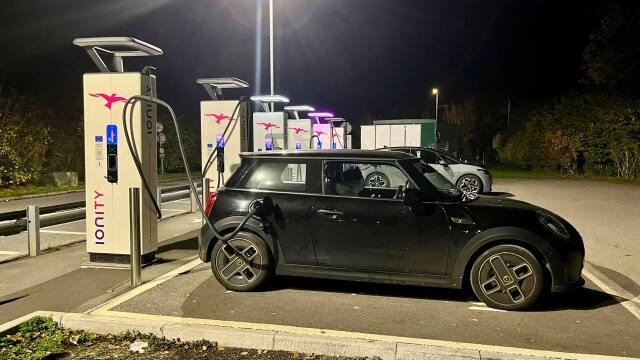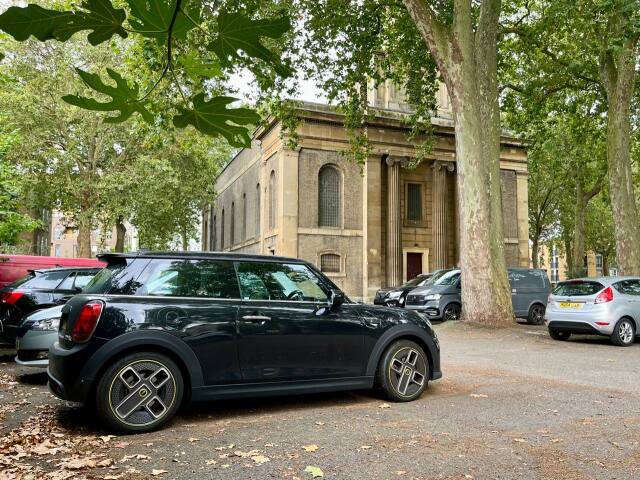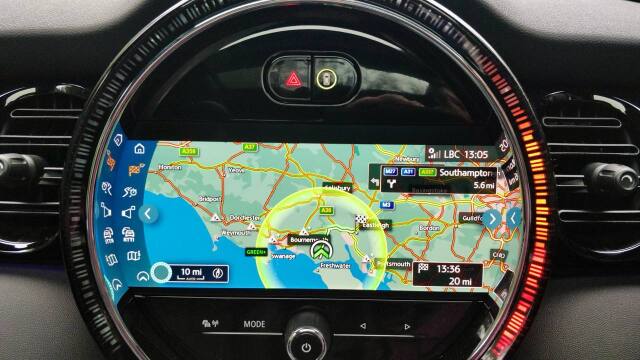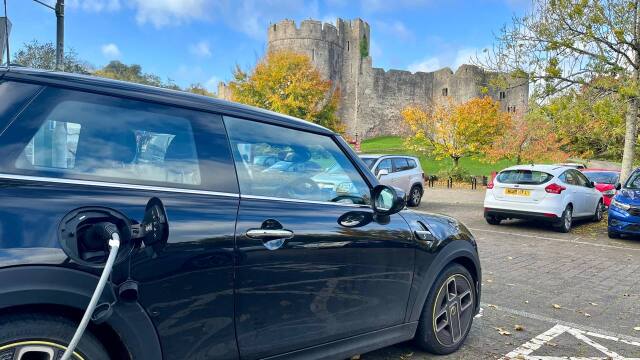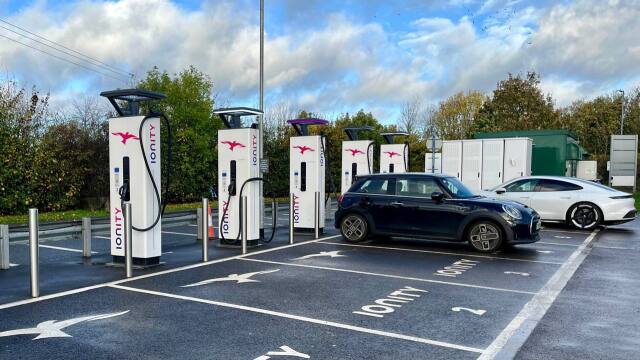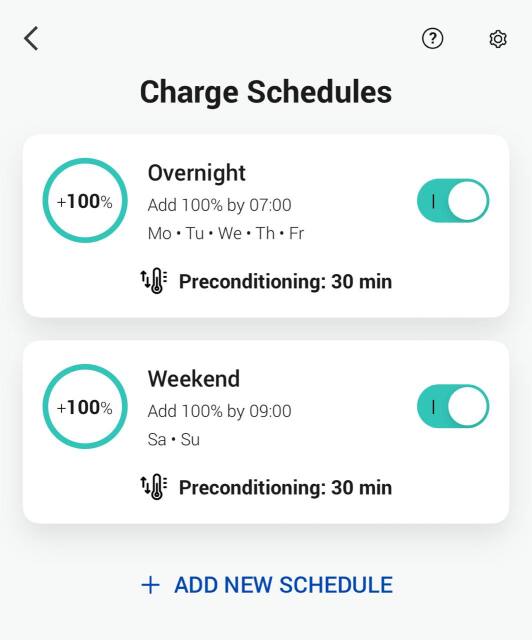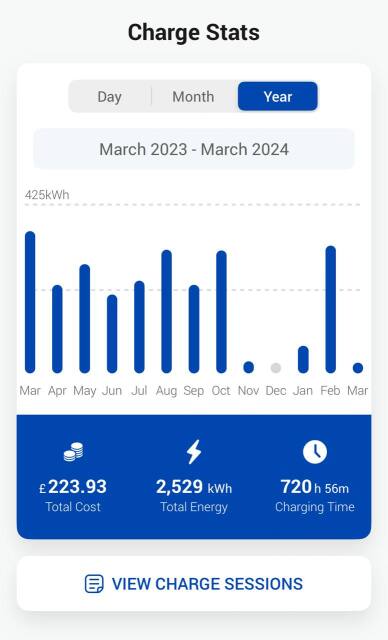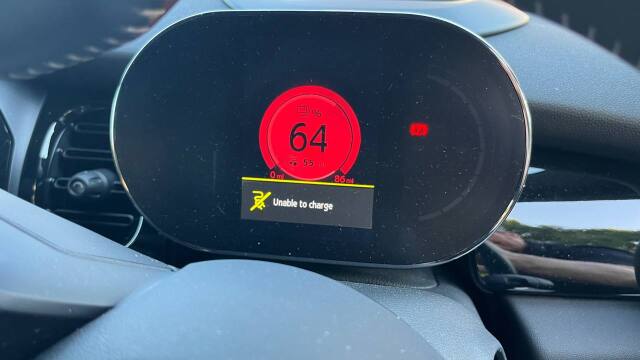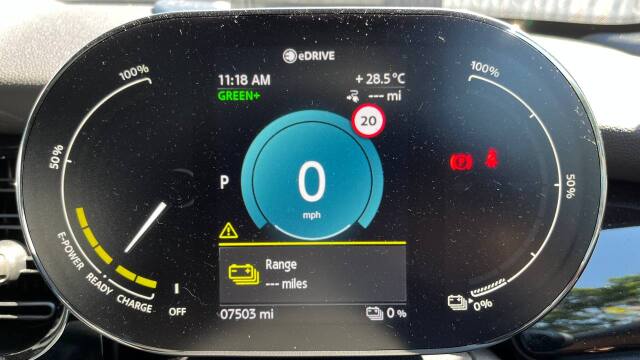tl;dr I have had a Mini EV for a little over two years, so I thought it was time for a retrospective. This isn’t so much a review as I’m not a car journalist. It’s more just my thoughts of owning an electric car for a couple of years.
I briefly talked about the car in episode 24 of Linux Matters Podcast, if you prefer a shorter, less detailed review in audio format.
Patreon supporters of Linux Matters can get the show a day or so early, and without adverts. 🙏
Introduction
In August 2020, amid [The Event], and my approaching 50th birthday, I figured it was about time for a mid-life crisis. So, after a glass of wine, late one evening, I filled in a test-drive request form for a Tesla electric car.
I was surprised to get a call from a Tesla representative the next day to organise the booking. A week later, I turned up at the nearest Tesla “dealership” in an industrial estate near Heathrow Airport to pick up the car.
I had maybe twenty minutes to drive the car alone, on a fixed route, and then bring it back. I’d never driven a fully electric car before that, nor even been in one as a passenger, that I recall. I’ve been in countless Toyota Prius over the years as the go-to taxi for the discerning cabbie.
I had no intention of buying the car, so we parted ways after the drive. The salesman was phlegmatic about this. He said it didn’t matter because now I’ve driven one and had a positive experience, I’d be more likely to rent a Tesla or talk about the experience with friends.
Not yet done the former; definitely have done the latter.
Shopping around
A year later, my pangs for a new car continued. I also took a Citroen EC5 out for a spin and borrowed a Renault ZOE. Both were decent cars, but not really what I was after. The Citroen was too big, and the ZOE had an ugly, fat arse-end.
Then I took a look at the Mini. Initially, it wasn’t on my radar, but then I watched every video review and hands-on I could find. I was almost already sold on it when I took one out for a test drive. Indeed, after telling the amiable and chilled sales guy which cars I’d already test-driven, he said, “If you drive the Mini, you’ll buy it, not the others”.
“That is a bold claim!”, I thought.
He was right though. I bought one. Here it is some months later, at a “favourite” charging spot late one night.
I’ve had many cars over the years, some second-hand, a few hand-me-downs in the family, but never a new car for me, for my pleasure. I do enjoy driving, but less so commuting in traffic, which is handy now I’ve worked from home for over a decade.
Now the kids are grown up, and the wife has a slightly larger car if we all go somewhere. I can get away with a two-door car.
Specs
I went for the “2021 BMW Mini Cooper Level 3”, as it’s known officially. The design is from 2019 and has been replaced in 2024. Level 3 refers to the car’s trim level and is one of the highest. There were a few additional optional extras, which I didn’t choose to buy.
The one option I wish I’d got is adaptive cruise control, which is handy on UK motorways. Dial in a speed and let the car adjust dynamically as the car in front slows or speeds up. My wife’s car has it, and I am mildly kicking myself I didn’t get it for the Mini.
The full spec and trim can be seen in the BMW PDF. Here’s the page about my car’s specifications. Click to make it bigger.
I went for black paint and the “3-pin plug” inspired wheels. They’re quite quirky and look rather cool at low speed due to their asymmetry. Not that I see that view often, as I’m usually driving.
Here’s what it looks like when you’re speccing up the Mini online. This is a pretty accurate representation of the car.
Driving
The most important part of a car is how it drives. I love driving this thing. The Mini EV is tremendously fun to drive. It’s relatively quick off the mark, which makes it great for safe overtaking. Getting away from the lights is super fun too.
Being an EV, it’s got a heavy battery, so it’s doesn’t skip around much on the road. I’ve always felt in control of the car, as it drives very much like a go-cart, point-and-shoot.
Without a petrol engine, there’s certainly less noise and virbration while driving. Road and wind noise is audible, but it’s pretty pleasantly quiet when pootling around town. As required by law, it makes some interesting “spacey” noises at low speed, so pedestrians can hear you coming. Although I’ve surprised a few people and animals when they couldn’t.
Unlike the four-door Mini Clubman, it’s got long rimless doors, which make for getting in and out a bit easier. They also look cool. I’ve always enjoyed the look of a two-door coupe or hatchback car with rimless front windows.
There are four driving modes, Normal (the default), Sport, Green and Green+. Green+ is the eco-warrior mode which turns all the fans off, and reduces energy consumption quite a bit, extending the overall range. Sport is at the other end of the scale, consuming more power, being more responsive, and lighting the car interior in red, which is cute.
There are two levels of regenerative braking, which is on by default. I never change this setting, but you can. It means I can drive with one pedal, letting the regenerative braking reduce speed as I approach junctions or traffic. I rarely use the brake pedal at all.
The brake lights do illuminate when regenerative braking is occurring, which I’m sure is annoying for the person behind me when I’m hovering between go and stop. The car doesn’t come to a complete stop if you remove your feet from the pedals, so I do have to use the brake pedal to completely stop the car, which is a shame.
Driving in London
London has a Congestion Charge (CC), and (controversial) Ultra Low Emissions Zone (ULEZ). Cars have to pay to enter the centre of London. There are some exceptions. As the Mini is electric, it currently doesn’t have to pay the CC. However in order to qualify for not paying the £15 daily charge, you have to pay a £10 annual charge.
I sometimes use “JustPark” to find interesting places to put the car while I’m in London. Here I found a spot in the grounds of an old church.
I have always loved driving in central London, I’ve used this perk a fair few times to drive into the centre of London for work, to meet friends or go out in the evening. It’s cheaper for me to drive into the centre of London and park than it is to get a return train ticket, which is mad.
Space
It’s a two-door car that can seat two adults comfortably in the front and two kids in the back. Or four adults uncomfortably as the legroom in the back is quite cramped. I never sit in the back, so I don’t care about that.
On the odd occasion, the four of us (two adults and two teenage kids) have been in the car together, it’s been fine. I wouldn’t do a long journey like that, though.
The seats are comfortable, even for a relatively long drive, and being small, everything is very much within reach. I’m almost 6ft tall and fit just fine. However, with the seat far back, my view of traffic lights when in the front of a queue is somewhat limited. The mirror also obscures my view more than most cars, as it’s parallel to my eyes rather than “up and to the left” as it would be in a larger cabin.
There are two sunroofs, each with a manual sliding mesh shade on the underside. The front roof can be tilted or slid open using a switch in the overhead panel. The rear sunroof doesn’t open.
Interior
The interior is a mix of retro Mini styling and new fangled screens. It has a big round central circle harking back to the original Mini speedo. Here though, it contains a rectangular display. There are physical controls for air conditioning, seat warmers, parking assistance, media controls, navigation, the lot. While the display is a touch screen, that’s rarely needed when using the built-in software.
It looks like this, but with the steering wheel on the right (correct) side.
I should mention that I don’t like the buttons on the steering wheel, nor those immediately under the display. They’re flat rocker-style ones, which you have to look at to find. The previous generation of Mini had raised round buttons, which are much easier for fingers to find.
The built-in navigation system is pretty trashy, like most cars. I’ve never found a car with a decent navigation system that can beat Android Auto or Apple Car Play. I also like using Waze, Apple Maps, and a podcast app while driving.
In this photo, you can see the navigation display, which highlights the expected current range with the circle around the cars location. Also note the “mode” button which is one of the flat ones I dislike in the car. The lights around the display illuminate to show temperature of the heating, or volume of the audio system, while you adjust it.
One benefit of the onboard navigation system is that driving instructions and lane recommendations appear on the Head-Up Display (HUD) in front of the driver. The downside of mobile apps on the mini is they don’t have access to the HUD, so I have to glance across at the central display to see where I need to turn. Alternatively, I could turn the volume on the mobile map app up, but that would interrupt podcasts in an annoying way.
I suspect this is a missing feature of the BMW on-board software, which may be fixed in a later release. I drove a brand new BMW which had a similar HUD that integrated with the navigation system on my phone. Mine doesn’t have that software though.
The back seats can be folded to provide more boot space, especially in a car with little luggage space. I’ve used the Mini for a ‘big shop’ with the seats folded down and can get plenty of ‘bags for life’ in there, full of groceries.
There’s the usual media controls on one side of the steering wheel, as well as cruise and speed limit control on the other. Window, sunroof and other important controls all have buttons in the expected places. A minimalist button Tesla, this is not.
There’s an induction phone charger inside the armrest. The best part about this is with Apple CarPlay, I can just hide the phone in there, charging, so I’m not distracted while driving. The worst part is I frequently forget the phone is in there, and leave it when walking away from the car.
Power
The Mini is a BEV (battery EV) instead of a PHEV (plug-in hybrid EV) - like a Prius or BMW i3, so it has no petrol engine but relies on the battery powering a single motor to propel the car.
The Mini is sold with only one battery option, a 30KwH capacity with an estimated 140-mile range. There’s a CCS (Combined Charging System (combo 2)) socket under a flap on the rear (right) driver’s side. So it can do slower AC charging or faster DC charging.
The car has all the cables required for charging from a 13-amp socket at home or a 7Kw domestic or public “slow” charger. Faster public chargers have integrated fat cables.
A few days before the car arrived, I had a charger installed at home on the outside wall of the house. I’m fortunate to have a driveway at the front of the house. So I typically park the car on it and plug in when I get out.
Sometimes, I forget or don’t bother if I know the battery still has plenty of charge and I do not have any upcoming long journeys. But more often than not, I try always to plug it in, even if it won’t be charging until the next day.
Charging
In my personal experience, most charges are done at home. I have charged in many places away from home, but that’s not very common for me. The last time I checked the stats, it had been around 86% charging at home and 14% on public chargers.
I often take a photo of the car while it’s charging in a public place. Usually to share on social media to spark a conversation about charging infrastructure. On this occasion I was using a charger in the car park at Chepstow Castle.
I know petrol heads often bleat about the very idea of waiting while the car fills up, but sometimes it leads to nice places, like this. This was a pretty slow charger, but I didn’t really care, as I had a castle to walk around!
Sometimes the locations are less pretty. This is Chippenham Pit-Stop, which does a great breakfast while you wait for your car to charge.
Ohme at HOME
My home charger is made by Ohme. It has a display and a few weatherproof buttons to be directly operated without needing an app. However, a few additional features are only available if the app is installed.
The Ohme app can access my energy provider via an API which lets the charger know when is the optimal time to start changing the car, from a pricing perspective. That seems to work well with Octopus Energy, my domestic provider.
It’s possible to define multiple charging schedules to ensure the car is ready for departure at the time you’re leaving.
The Ohme app is also supposed to be able to talk to the BMW API with my credentials, in order to talk to the car. This has never worked for me. I have had calls and emails with Ohme about this, but I gave up in frustration. It just doesn’t work.
That doesn’t stop the car from actually charging though. Indeed, according to the stats in the app (which I only discovered while writing this blog) - I’ve charged for over 720 hours at home in the last twelve months. The dip in November & December is explained below under “Crash repair”.
Issues
There are a few issues I’ve had with the car.
App registration
The car has its own mobile connectivity, and talks to BMW periodically. But for that to work, you have to successfully pair the car with your phone app. The pairing process between the mobile app and the car itself should just be a case of entering the Vehicle Identification Number in the app. Sadly this didn’t work. I don’t know what was wrong, but it took around two weeks for it to be fixed.
Home Sweet Home
The onboard navigation system had my address wrong. The house number it showed for my home doesn’t exist, and mine wasn’t in the database. The house has been here and numbered correctly for over 50 years. It was only a minor thing because I happened to know where I lived, and how to get there. It just irritated me that my own car, on my driveway, thought it was somewhere else.
I called Mini customer services and they didn’t seem to think it was easily fixable, and I should just hope for a map update.
So I did the nerd thing, and found out who the map supplier was - “Nokia Here” - and submitted a request to fix the data there. Later, I got a map update from BMW which contained my fix. That’s one way to do it.
Unable to charge
Within a year of owning the car, it stopped charging at home. The AC charging port just wouldn’t work. I could charge at the fast public DC chargers nearby, but my home charger stopped working.
When I reported the problem to BMW, their assumption was that the wall box on my house was broken. We disproved this by showing a different car charging from the home wall box, and my car refusing to charge from public AC chargers.
The BMW dealership were still very reluctant to accept that there was a problem with the car. I had to drive it to the dealership and put the car on their own slow charger to show them it failing to charge. Only once I’d done that did they allow me to book it in for repair the next day.
In a bit of a dick move, I drove around to empty the battery completely, rocking up to the dealership with the car angrily telling my it had 0% charge. That way they’d have to fix it to charge it to get it back to me. They did indeed fix the problem with the charging system, which took quite a while.
I got a rather fancy BMW i7 on loan while they repaired the car.
When I went to pick the car up, they were very apologetic that it took so long and gave me a bag of Mini merch as a gift. When I went to open the boot to put the bag away, I noticed that there was a panel unclipped and some disconnected wires dangling around in the boot. I had to call someone from the garage over to fix it before I could drive away.
I was a little sad that the car clearly hadn’t been fully checked over before I was given it back.
Unplugging
During cold weather in Winter, the charger plug sometimes gets stuck - frozen - into the socket. This can be quite frustrating as it’s impossible to set off to work while the cable is still attached to the house! I found some plumber grease which I smeared around the plug in the hope of lubricating and reducing the ingress or condensation of water. So far, that’s helped.
Navigation
I took a wrong turn down a long A-road one night, which meant I didn’t have sufficient charge to get home without stopping to top up. I thought I’d try the internal navigation system, which has a database of charging stations.
The first location it took me to was a hotel. I drove around the car park and couldn’t find a charger at all. Not necessarily the navigation system’s fault, but the hotel signage, to be fair. I gave up, and chose the next nearest charger on the map. It confidently took me down some narrow lanes and stopped at a closed gate which was the entrance to a farm. It looked to me like a private residence.
I gave up and switched to an app on my phone, and ended up at a nearby Tesla charging station where there we many free spaces, and I was able to charge with ease. It possibly should have offered me that one first!
App nagging
As I mentioned above, there is a Mini app for Android and iOS for managing the car. In it you can do some simple things like lock and unlock the car, turn the lights on, and enable the climate control before setting off. It also has a record of charging sessions, a map for finding chargers, and other useful information like locating the car, and showing battery charge level and estimated range.
It nags you constantly to tell them how great or bad the app is, and inexplicably on a scale of 0 to 10, whether you’d recommend it to friends or colleagues. I cannot fathom the kind of person who recommends apps to friends who do not own the car which the app is for. It’s completely mental.
Every time the dialog comes up - and it’s come up a lot - I rate the app zero, and leave an increasingly irritated message to the developers to stop asking me. I have also filed a ticket with BMW. Their engineers came back to me with details of exactly how often it asks, based on how often you open the app, and the interval between one opening and the next.
You can’t turn this off. It’s super irritating, and I still get asked two years later. I still give it a zero, despite the app having some useful features.
Full flaps
The charge port is covered by a hinged flap, just like in a petrol car. The Mini recently started nagging me that the flap was open when it wasn’t. No amount of opening and closing would stop the car nagging me. Thankfully it still let me drive with a little warning triangle on screen. I let the dealership know, and they fixed it during the upcoming maintenance.
Crash repair
In November my wife was involved in a crash when someone pulled out in front of her from behind traffic. She was only minorly injured, and the car was structurally fine, but a bit smashed up at the front. The other driver was at fault, and it was all sorted out via insurance. The local BMW-approved repair centre had the car from November to January while I had a hire car on loan. The car came back as good as new.
No spare tyre
It’s a small car, so there’s no room for a spare wheel. I had a puncture recently and managed to limp the car back home. I pressed the SOS button in the car and got put through to a friendly agent.
They organised a BMW engineer to come out and change the wheel. He arrived very quickly, jumped out of his van and took the wheel off my car, replacing it with a spare he had in the van.
He then put my wheel in the boot of my car and asked me to text him know once I’d got mine fixed, so he could pick his spare up again. I got it fixed within a day or so, and left his spare somewhere safe, as I was out at work. He happily came and collected it. I was pretty pleased with this whole experience.
Maintenance
As I got closer to the two-year anniversary of ownership, the app started to remind me to book the car for a service. There’s a feature in the app to just press a button, and get taken to a page where you can book the car in. The links are all broken and always have been. I don’t have the energy to call BMW to tell them it’s all broken. They should do better QA on the app.
Eventually I just called the garage to get the car maintained. There was a scheduled two-year inspection, a low priority recall, brake check and my broken ‘fuel flap’ to fix. They had the car all day and everything was complete when I picked it up at the end of the day.
The fact that there’s no oil changes, oil filter replacement, spark plug replacments, timing chain/belts, and many other parts that fail on an EV is quite attractive. But there’s still a regular service which needs doing.
Some argue that due to the car having a one-pedal driving mode, where regenerative braking slows tha car down, drivers are less likely to wear out the brakes. However I’ve also seen it asserted that some cars actually use both regenerative braking and the physical disc brakes without letting the driver know. I have no idea whether the Mini actually “smartly” applies the brakes, or if it only does so when I press the brake pedal.
Conclusion
I love the Mini EV. I love driving it, and often make excuses to drive somewhere, or I’ll go the ‘long way round’ in order to spend more time in it. It’s not perfect, but it’s super fun to drive.
As for it being my first EV. While the network of public EV chargers isn’t amazing, there’s enough where I live and travel to service my requirements. I don’t think I’ll go back to a petrol car anytime soon.
We’re also considering replacing the wifes car soon, and will look at electric options for that too.
There’s a new refreshed Mini model out, that the local dealership salespeople seem to want me to test drive. Having seen it on video, but not in person, I’m not convinced I’ll like it. We’ll see.

